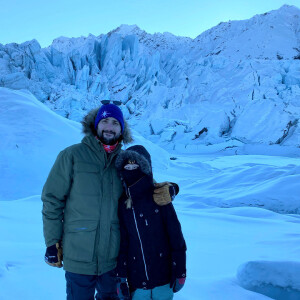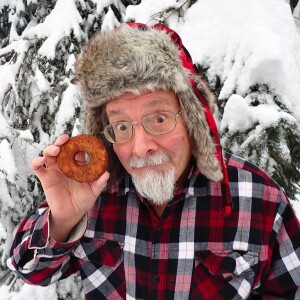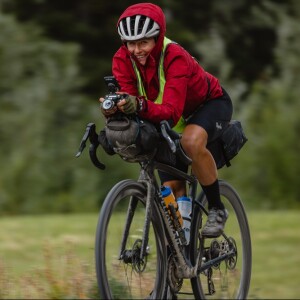Chatter Marks
Chatter Marks is a podcast of the Anchorage Museum, dedicated to exploring Alaska’s identity through the creative and critical thinking of ideas—past, present and future. Featuring interviews with artists, presenters, staff and others associated with the Anchorage Museum and its mission.
Episodes

Tuesday Nov 19, 2024
EP 98 A better future through design and landscape architecture with Jonny Hayes
Tuesday Nov 19, 2024
Tuesday Nov 19, 2024
Jonny Hayes is the the Chief Design Officer at the Anchorage Museum. But before he was at the Museum, he worked in architecture firms where he preferred to spend his time on projects that improved peoples’ lives. Like playground design and transportation. He enjoyed what he was doing there, but the more he learned about the Museum, the more he appreciated it as a community learning space, a place of knowledge where people came to learn. And then he realized how much the local community could benefit from the knowledge that comes from the archives and the artists and the community members that the Museum works with. He believed then, as he does now, that by sharing more voices visitors get a better sense of who we are as Alaskans.
The work that Jonny does finds itself at a cross-section of people and the places they live. That includes how people interact with each other and their environment, and how both of those things shape them. But how do humans interact with each other and with their environment? For Jonny, this is an ongoing and ever-evolving question. It applies to the work he does at the Museum, as well as his insight into city planning. So, he’s always thinking about how the city of Anchorage can be improved, be it through building construction, public spaces, or how roads impact communities and transportation. Because if we’re better oriented to our environment — both natural and urban — then we’re more equipped to live within the world that’s around us.

Wednesday Oct 30, 2024
EP 97 Telling Alaska’s story with Mr. Whitekeys
Wednesday Oct 30, 2024
Wednesday Oct 30, 2024
For over 50 years, Mr. Whitekeys has been entertaining Alaska with his music, his shows and his books. He started playing music in Anchorage in the 1970s at Chilkoot Charlie’s. In those days, the bars didn’t close until 5 am. So, a band could play for as long as 7 ½ hours — from 9 pm to 4:30 am. Keys says that for a musician it wasn’t about the entertainment, it was an endurance contest. From those years spent playing at Koots, he learned how to read an audience, to understand what entertains them. Then in 1980, he opened The Fly By Night Club. It featured long-running shows that parodied Alaska like “The Whale Fat Follies” and “Christmas In Spenard.” They had original songs, costumes, props, sets and slideshows. You could even get a meal of Spam there. The goal was to provide Anchorage with a cheap laugh, some infectious music and a good time.
Alaska, as it existed in the ‘70s, continues to influence Keys’ idea of Alaska. There was a renegade spirit to it back then, he says, and there wasn’t much influence from the Outside. There were no food chains, no big box stores and people lived how they wanted to live. That’s why he came to Alaska and he never left. It was unpretentious, just like Keys. In fact, at one point, he had a rule that he would never go to any entertainment-related event if they didn’t serve nachos. So, he laughs when asked what he thinks his legacy will be because he’s just a normal guy looking for a good time. Not someone to be put on a pedestal. But he says that if he did have one — if he did have a legacy — it would be that he spent his life telling Alaska’s story.

Monday Oct 21, 2024
EP 96 Around the world with Lael Wilcox
Monday Oct 21, 2024
Monday Oct 21, 2024
Lael Wilcox is an ultra-endurance cyclist and racer, and she recently set a women’s Guinness World Record for fastest time cycling around the world. The trip was 18,000 miles long and it took her 108 days, 12 hours and 12 minutes to complete. She averaged 166 miles a day. And with the help of some friends, she planned her own route. She wanted it to include the kind of riding she likes to do, which is a lot of climbing in the mountains. It’s slower and it’s harder, but it’s the riding that inspires her. Her route was intense, rewarding and challenging. She was especially grateful for finishing without any injuries. Considering how much road Lael covered, staying safe around vehicles was among her top priorities because regardless of what happens, her main goals are to always stay safe and to finish regardless of her standing.
She says that each race is an opportunity to prove something to herself. Sometimes that’s overcoming her fear of the route — like with cycling around the world and the Iditarod Trail. Other times it’s about being capable of doing these increasingly long and difficult rides. Her desire to chase these rides, these proving grounds, is all-consuming. To the point that when she finds herself thinking about them, she stops eating or she stops talking to focus on the idea and her intent. She imagines it all fitting together like a puzzle — every piece is important and it all fits together to form a bigger picture. Sometimes that involves spontaneity — she loves that. Adjusting to weather, keeping an eye out for places to sleep, seeing wildlife, meeting new people, experiencing other cultures and visiting new places.

Tuesday Sep 24, 2024
Tuesday Sep 24, 2024
Mike Livingston specializes in the cultural heritage of the Aleutian and Pribilof Islands. His background makes him uniquely qualified for this position. He grew up in Cold Bay, Alaska, located on the Aleutians, and his family homesteaded where Trout Creek flows into Cold Bay. He says they didn’t have much money, so they lived a subsistence lifestyle and built their home using remnants left on the island from World War II.
At 21, he moved to Unalaska and worked as a police officer for three years, then he moved to Anchorage and was an officer for the Anchorage Police Department for 20 years. In that time, he worked in a number of different departments: burglary, theft, felony assaults, the crimes against children unit, and the major crimes unit. His work in law enforcement and his research into the Unangax̂ region — in addition to a local murder he remembers from when he was 16 — eventually led him to his work with Murdered and Missing Indigenous Persons.
More recently, Mike’s been focused on ways to integrate ancient sod housing design into the construction of modern houses. Traditional sod houses were used in the Aleutian Islands and the Alaska Peninsula for at least 10,000 years. They were so energy efficient that their carbon footprint was virtually non-existent.
He’s also been working on correcting historical inaccuracies of Benny Benson, the boy who designed the Alaska flag in 1927. The research he’s involved in found that Benny was not of Alutiiq heritage, like it’s been believed for decades, but of Unangax̂ heritage.

Tuesday Sep 10, 2024
EP 94 Chasing an Olympic dream with Kristen Faulkner
Tuesday Sep 10, 2024
Tuesday Sep 10, 2024
Kristen Faulkner is a professional cyclist and she recently won gold in two events at the 2024 Paris Olympics, women's individual road race and women's track cycling team pursuit. It was a dream come true. Ever since she was a kid — growing up in Homer, Alaska — she wanted to compete in the Olympics. As a young girl, she’d watch it on TV and it was the only time she saw women competing in professional sports. But it takes more than just a dream and a positive attitude to make it to the level that Kristen’s at now. She says there’s a process: You have to be humble and analytical and constantly learning. You also have to be willing to take risks.
In 2016, Kristen graduated from Harvard and then took a job in New York and then in San Francisco as an investment associate. She was in her mid-twenties when she quit that job and started pursuing a career in cycling. It was a decision that she agonized over — to leave a lucrative job for an uncertain one. But she eventually determined that the pros outweigh the cons, that she would rather live with no regrets.
Her approach to cycling, like everything in her life, is about assessing what you’re good at and what you’re bad at. And then when you’ve identified what you’re bad at, you focus on it until it’s a strength. This is one of the reasons she excelled in cycling so quickly: She made her weaknesses her strengths. She approached it with the mentality of, “It’s not that I’m bad at it, it’s that I’m just not good at it yet.”
Photo by Anouk Flesch

Thursday Aug 22, 2024
EP 93 Orange rivers and the Greening of the Arctic with Paddy Sullivan
Thursday Aug 22, 2024
Thursday Aug 22, 2024
Paddy Sullivan is an ecologist, and every year he travels to the Brooks Range in northern Alaska to collect snowpack samples. The area he visits is remote and often inaccessible. The Salmon River, for example, is a place where bush planes rarely land. They’ll land outside of the watershed and then people walk in. Paddy’s been going here for 20 years now, and in that time he and Roman Dial — an adventurer and fellow scientist — have formed a hypothesis about why the area is changing so much: The retreat of sea ice fuels increasing snowfall and nearby landmasses, protects seedlings and improves soil nutrient availability. And all of this allows for shrubs to proliferate and trees to advance into the tundra. It’s called the Greening of the Arctic and it’s changing the land; It’s also changing how people and wildlife use the land.
In 2019, while Paddy and Roman were collecting their datasets they stumbled upon something concerning and out of place: The once gin-clear Salmon River had turned orange. They noticed other rivers and streams had turned orange as well. In all the years they’d been coming to the Brooks Range, they’d never seen anything like it. So, they decided that they needed to sound the alarm, to let other scientists know what was going on up there. And hopefully, with their help, they could figure out what the implications were for humans and the surrounding ecosystems. Because something like this — an occurrence that trickles down into other ecosystems — has the potential to trigger ecosystem collapse. This happens when the rules of an environment are altered in a way that forces wildlife and vegetation to change how they interact with their environment.

Friday Aug 09, 2024
EP 92 Reporting on the Alaska fishing industry with Laine Welch
Friday Aug 09, 2024
Friday Aug 09, 2024
Laine Welch has been reporting on the Alaska fishing industry for 36 years, and during those years her goal was always to show where Alaska fits into the global commodities market because seafood is one of the largest commodity items sold throughout the world. Given Alaska’s commercial fishing market, there’s always been a real opportunity to be a major player in the global seafood market. But Laine says we tend to squander our potential profits. For example, there are plenty of revenue streams that could be taken advantage of in areas like cosmetics and pharmaceuticals. Or how almost 75 percent of all of the value from groundfish — Alaska’s number one species in terms of volume — goes out of state. Primarily to Seattle.
She says that when she first started reporting on the Alaska fishing industry she tamped down her criticism of it, and instead chose to be its cheerleader. But when she retired two years ago, she felt a new sense of responsibility and freedom to point out areas of the industry that could use improvement. She was no longer beholden to only reporting on the good or acceptable news. So, in retirement, she’s been focusing on issues like the lawful waste of seafood caused by bycatch — the catching and discarding of unwanted sealife. She says that every other protein industry has a philosophy of using the whole animal, what they call ‘from the rooter to the tooter.’ But in Alaska, they take the filet and the rest goes. This has always been important — avoiding waste and maximizing profit — but it’s especially important now, when the economy of Alaska needs new revenue streams.

Wednesday Jul 24, 2024
EP 91 Pastries, science and baking in extreme environments with Rose McAdoo
Wednesday Jul 24, 2024
Wednesday Jul 24, 2024
Rose McAdoo is a pastry chef and an artist. But it wasn’t until recently that she started embracing the title of artist because she had identified so strongly with being a pastry chef.
She’s been working in kitchens since she was 14, and then when she became a chef she decorated wedding cakes in New York. It was a dream job, until it wasn’t. She realized that she wanted more out of her work, an opportunity to make a difference. So six years ago she took a job in Antarctica as a sous chef — today she splits her time between there and Alaska. Her surroundings and the scientists she worked around in Antarctica eventually inspired her to create something that could help share their science. That’s when she began creating cakes that convey scientific ideas.
She’s traveled to and worked in some of the most extreme and remote environments in the world — Antarctica, a volcano summit in Kenya, underground in the Australian Outback, on a ship in Svalbard. Rose says that nothing is controllable in these places, and that the control lies in the planning she does before she goes into a given environment. She has to be flexible and able to pivot because the weather and the conditions could change at any minute.
Given the seriousness of the environments she works in, she appreciates the levity of cake. How it allows people to let their guard down and be receptive to scientific ideas about issues like climate change. However, she does struggle with the potential impact of what she’s doing — she says she doesn’t want to be seen as a “little cake maker just posting on Instagram.” She wants her work to carry meaning and to create larger conversations.


